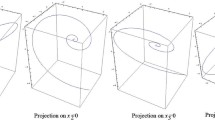Abstract
We point out (and then apply to a general situation) an unusual relationship among a variety of null geodesic congruences; (a) the generators of ordinary light-cones and (b) certain (related) shear-free but twisting congruences in Minkowski space–time as well as (c) asymptotically shear-free null geodesic congruences that exist in the neighborhood of Penrose’s \(I^{ +}\) in Einstein or Einstein–Maxwell asymptotically flat-space–times. We refer to these geodesic congruences respectively as: Lignt-Cones (LCs), as “Almost-Complex”-Light-Cones (ACLCs), [though they are real they resemble complex light-cones in complex Minkowski space] and finally to a family of congruences in asymptotically flat-spaces as ‘Almost Light-Cones’ (ALC). The two essential points of resemblance among the three families are: (1) they are all either shear-free or asymptotically shear-free and (2) in each family the individual members of the family can be labeled by the points in a real or complex four-dimensional manifold. As an example, the Minkowski space LCs are labeled by the (real) coordinate value of their apex. In the case of (ACLCs) (complex coordinate values), the congruences will have non-vanishing twist whose magnitude is determined by the imaginary part of the complex coordinate values. In studies of gravitational radiation, Bondi-type of null surfaces and their associated Bondi coordinates have been almost exclusively used for calculations. It turns out that some surprising relations arise if, instead of the Bondi coordinates, one uses ALCs and their associated coordinate systems in the analysis of the Einstein–Maxwell equations in the neighborhood of \(I^{+}\). More explicitly and surprisingly, the asymptotic Bianchi Identities (arising directly from the Einstein equations), expressed in the coordinates of the ALCs, turn directly into many of the standard definitions and equations and relations of classical mechanics coupled with Maxwell’s equations. These results extend and generalize the beautiful results of Bondi and Sachs with their expressions for, and loss of, mass and linear momentum.
Similar content being viewed by others
References
Bondi, H., van der Burg, M.G.J., Metzner, A.W.K.: Proc. R. Soc. Lond. A 269, 21 (1962)
Sachs, R.K.: Proc. R. Soc. Lond. A 270, 103–126 (1963)
Abbott, B.P.: LIGO scientific and virgo collaborations. Phys. Rev. Lett. 116, 061102 (2016)
Penrose, R., Rindler, W.: Spinors and Space–Time, vol. 2. Cambridge University Press, Cambridge (1986)
Newman, E.T., Penrose, R.: J. Math. Phys. 3, 566–578 (1962)
Newman, E.T., Penrose, R.: Spin-coefficient formalism. Scholarpedia 4(6), 7445 (2009)
Adamo, T.M., Newman, E.T., Kozameh, C.: Living Rev. Relativ. 15, 1 (2012). http://www.livingreviews.org/lrr-2012-1 (update of lrr-2009-6)
Kozameh, C., Newman, E.T.: Class. Quantum Grav. 22, 4659–4665 (2005)
Kent, S.L., Newman, E.T.: J. Math. Phys. 24, 949 (1983)
Newman, E.T., Unti, T.: J. Math. Phys. 3, 891 (1962)
Hansen, R.O., Newman, E.T., Penrose, R., Tod, K.P.: Proc. R. Soc. Lond. A. 363, 445–468 (1978)
Szabados, L.B.: Living Rev. Relativ. 12, 4 (2009). doi:10.12942/lrr-2009-4
Landau, L., Lifschitz, E.M.: Classical Theory of Fields. Addison-Wesley, Reading (1962)
Acknowledgements
We thank Timothy Adamo for hours of wonderful discussions and collaboration on an earlier manuscript where many of the present ideas were developed. Roger Penrose is owed, almost beyond thanks, for his insight, his enlightening remarks and his encouragement and support—both recently and over the years.
Author information
Authors and Affiliations
Corresponding author
Rights and permissions
About this article
Cite this article
Newman, E.T. Light-cones, almost light-cones and almost-complex light-cones. Gen Relativ Gravit 49, 102 (2017). https://doi.org/10.1007/s10714-017-2264-1
Received:
Accepted:
Published:
DOI: https://doi.org/10.1007/s10714-017-2264-1



